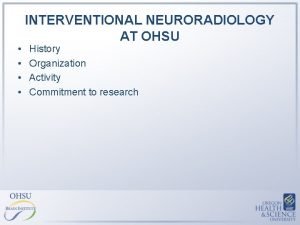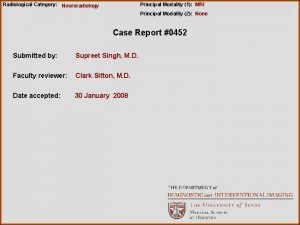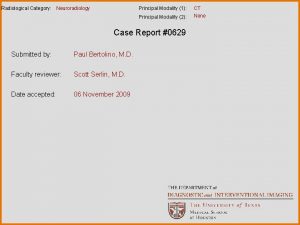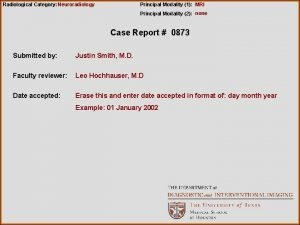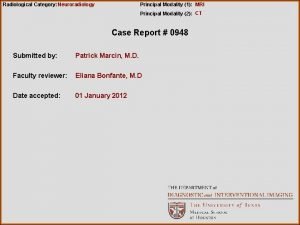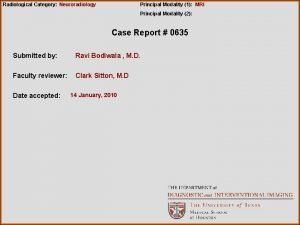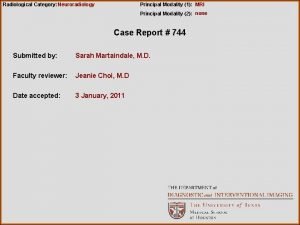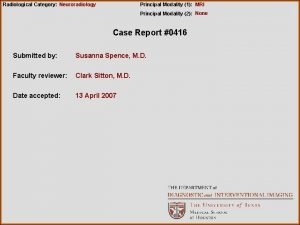Radiological Category Neuroradiology Principal Modality 1 MRI Principal









- Slides: 9

Radiological Category: Neuroradiology Principal Modality (1): MRI Principal Modality (2): None Case Report #0146 Submitted by: Karen Seaberg, M. D. Faculty reviewer: Leo Hochhauser, M. D. Date accepted: 29 December 2004

Case History 33 year old male with long history of headaches presents with 3 week history of diplopia and 6 th nerve paresis.

Radiological Presentations

Radiological Presentation

Test Your Diagnosis Which one of the following is your choice for the appropriate diagnosis? After your selection, go to next page. • Apical petrositis • Cholesterol Granuloma • Congenital Cholesteatoma • Mucocele • Chordoma

Findings and Differentials Findings: Image 1: T 1 image demonstrates hyperintense lesion within the right petrous apex Image 2: T 2 image demonstrates hyperintense lesion within the right petrous apex Image 3: T 1 postcontrast image demonstrates no enhancement of the lesion Differentials: • Cholesterol granuloma • Acquired cholesteatoma • Apical Petrositis • Hemorrhagic bony metastasis

Discussion Cholesterol granulomas are currently thought to result from obstruction of the petrous air cells. The obstruction leads to development of negative pressure within the air cells with resulting repeated hemorrhage from the rupture of blood vessels. The degradation of red blood cells results in cholesterol crystals and foreign body reaction which cause the lesion to expand rather slowly. While patients may present with cranial nerve dysfunction or headaches, the lesions are often asymptomatic and only found incidentally. Typical CT findings include a smoothly marginated lytic lesion centered in a pneumatized petrous apex, often containing soft-tissue debris. The lesion usually demonstrates high T 1 and high T 2 signal on MR secondary to the presence of hemorrhage, blood break-down products and cholesterol crystals. Post-contrast imaging demonstrates no evidence of enhancement.

Discussion Differential diagnosis includes acquired cholesteatoma, mucocele and apical petrositis. Acquired cholesteatomas may be differentiated from cholesterol granuloma by MR, acquired cholesteatomas are intermediate signal on T 1 and high signal on T 2 (cholesterol granulomas are high signal on all pulse sequences). Mucoceles may be bright or dark on all pulse sequences depending on the state of hydration of the secretions. However, mucoceles typically have peripheral enhancement. Apical petrositis typically is low signal on T 1 and bright signal on T 2 with a thick enhancing rim.

Diagnosis Cholesterol granuloma References: 1. Osborn, A. , Diagnostic Radiology; 1994. p 448. 2. Grossman, R. , Neuroradiology: The Requisites; 2003. pp 600 -602.
 Ohsu neuroradiology
Ohsu neuroradiology E-rate category 1 vs category 2
E-rate category 1 vs category 2 Radiological dispersal device
Radiological dispersal device Tennessee division of radiological health
Tennessee division of radiological health Center for devices and radiological health
Center for devices and radiological health National radiological emergency preparedness conference
National radiological emergency preparedness conference Mri principal
Mri principal Cardinality and modality
Cardinality and modality Cardinality and modality
Cardinality and modality Entity class in software engineering
Entity class in software engineering
